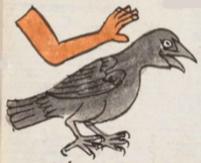Cacalomacan (Mdz33r)
Cacalomacan (Mdz33r)
This compound glyph represents the place name Cacalomacan. It includes a crow (cacalotl) and an arm with a hand (maitl). The locative suffix -can is not shown visually. The crow is a dark gray, shown in profile, looking to the viewer's right. Its beak is open, perhaps a subtle commentary on the crowing sound they make. The human arm above the bird is bent at the elbow, and the open (left) hand appears above the head of the bird.
Stephanie Wood
The open hand is poised to grab or capture (ma) the bird, which adds a possible layer of graphic syllepsis, overlapping with maitl.
Stephanie Wood
c. 1541, but by 1553 at the latest
nombres de lugares, ave, aves, pájaro, pájaros, pluma, plumas

cacalo(tl), crow, https://nahuatl.wired-humanities.org/content/cacalotl
ma(itl), arm/hand, https://nahuatl.wired-humanities.org/content/maitl
ma, to grab or capture, https://nahuatl.wired-humanities.org/content/ma-0
-can (locative suffix), https://nahuatl.wired-humanities.org/content/can-2
Codex Mendoza folio 33 recto, https://digital.bodleian.ox.ac.uk/objects/2fea788e-2aa2-4f08-b6d9-648c00..., image 76 of 188.
The Bodleian Libraries, University of Oxford, hold the original manuscript, the MS. Arch. Selden. A. 1. This image is published here under the UK Creative Commons, “Attribution-NonCommercial-ShareAlike 3.0 License” (CC-BY-NC-SA 3.0).
